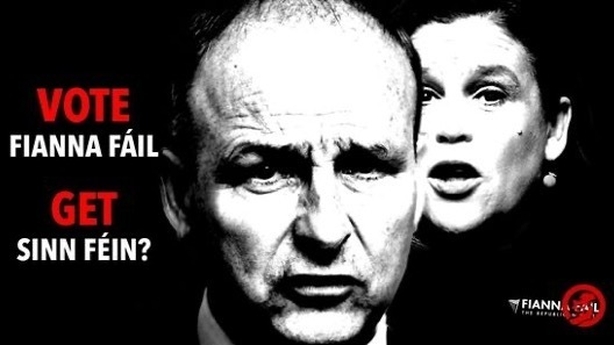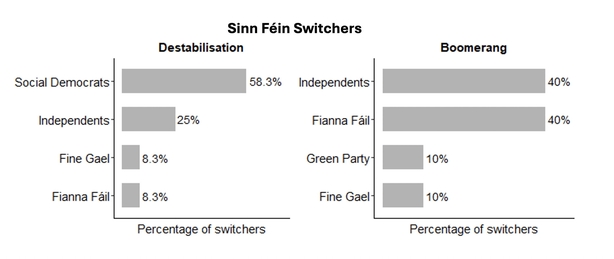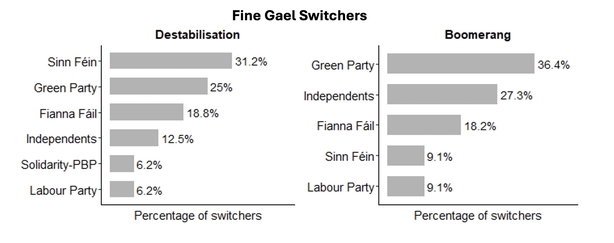Analysis: researchers found that a party who heavily invests in negative messaging may both gain and lose voters as a result
By Michele Crepaz, Queens University Belfast; Alan Duggan, University of Nottingham and Liam Kneafsey, TCD
Political parties in Ireland spend considerable time and resources on negative campaigning. Much of this comes in the form of leaflets or social media ads directly attacking the ideas, qualifications and issue positions of political opponents for electoral gain, rather than focusing on their own achievements and future plans.
While this strategy is common in Western politics, experts have noted the increasingly negative and bitter tone of Irish elections, particularly between the larger parties on the government and opposition benches. The production of negative messages is elaborate, with words, colour and tone playing key roles in communication strategies. The big question is, though, do these attacks pay off?
A month before the 2020 General Election, Fianna Fáil leader Micheál Martin declared that a series of social media attacks by Fine Gael on his party were "counterproductive" because "Irish people do not respond well to negative campaigning." However, during the same election, it was also evident that Fine Gael were asking applicants to join their research team to design attacks on Sinn Féin as part of the selection procedure, suggesting production of negative ads would be a substantial part of the job.

As political scientists, this was puzzling to us: why invest so much in negative ads if they don't work? The short answer is that we don’t know if negative campaigning works in Ireland. This is because most existing research has been conducted in the US or in European contexts where two candidates face each other in a plurality system.
In Ireland, the single transferable vote system means predicting what negative messages do to voters is much more complex. Would negativity actually hurt the target? Do voters switch to the attacker when they have lots of other choices? Or do they end up voting for smaller parties? There are too many unknowns.
To tackle these questions, we conducted a survey with almost 1,200 Irish voters, recruited through the Ireland Thinks polling company. The participants in the study were all partisan voters of either Fine Gael or Sinn Féin, the largest parties in terms of vote share at the time according to polling.
We need your consent to load this rte-player contentWe use rte-player to manage extra content that can set cookies on your device and collect data about your activity. Please review their details and accept them to load the content.Manage Preferences
From RTÉ News' Your Politics podcast, is the year of elections becoming the year of aggression?
Respondents were asked to fill out a mock ballot having watched a negative message distributed on Facebook. We manipulated these messages, showing Fine Gael-sponsored messages attacking SF to half of the participants and Sinn Féin-sponsored ones attacking FG to the other half. We then compared the results of their mock ballot to their voting intentions before seeing the message to capture the effects of the negative content.
What we found was that a large majority of voters in our experiment did not change their mind. This is not surprising, given that we did not expect individuals to change their minds easily after a single exposure to a negative message, especially when they were already partisan voters.
However, a small proportion of voters (49 out of 1,148) did change their order of preferences on the ballot, either penalising the attacked party or even the sponsoring party, as if the negativity backfired (or boomeranged). These results were statistically significant in our analysis, meaning they can be considered systematic in our data with a high degree of confidence.

The number of what we call 'switchers' seems small, accounting for only 4.3% of the participants, but can—in our view—be considered relevant. This is because partisan voters of Fine Gael and Sinn Féin, our participants were the least likely to change their mind and seats in Ireland are often won based on a handful of votes.
We looked more into these ‘switchers’ and discovered they associated the negative messages with feelings of anger and anxiety. This was true for those who saw their preferred party being attacked and for those who saw their favourite party engaging in negative communication. In the former group, the negative messages worked as the political parties intended while in the latter group, which accounts for approximately half of all switchers, the negative message backfired. Voters that changed their mind also had lower certainty of vote choice (25% lower than other participants in the study).

The next question is where did the switchers' votes go? We tracked this through respondents' voting choices and found some, but not drastic, differences between Fine Gael and Sinn Féin voters. Switcher voters of both parties changed their preference ranking in favour of transfer-friendly parties, both when their initial choice was destabilised and in the case of the boomerang effect.
However, we also observed some more radical shifts that we did not expect among partisan voters. 31% of the Fine Gael switchers who saw their party attacked by Sinn Féin seemed convinced by the messages and decided to promote Sinn Féin on their mock ballot. This pattern exists among Sinn Féin voters as well, but it is smaller, accounting for 8.3% of the Sinn Féin switchers.
We need your consent to load this rte-player contentWe use rte-player to manage extra content that can set cookies on your device and collect data about your activity. Please review their details and accept them to load the content.Manage Preferences
From RTÉ Radio 1's Today with Claire Byrne, the history and modern use of political attack ads
Taken together, our results suggest that Micheál Martin might have been wrong in assuming negative messaging does not work in Ireland. Contrary to the expectations parties may have, it produces both destabilising and boomerang effects. If our findings hold in the real world, then a party that heavily invests in negative messaging may both gain and lose voters as a result. In our study, this was true even among partisan voters, who should be the least likely to change their mind. These effects may be even larger among undecideds, who account for a growing proportion of Irish voters.
There are reasons to draw only careful conclusions from our study. Ours is a one-off experiment that cannot fully account for the real-world complexities of political communication. Campaigns invest in repeated messaging, micro-targeting and a mix of positive and negative tones. We don't know exactly how voters react to this complexity.
However, experiments have the advantage of allowing research to isolate one element from the rest. From our study, we can safely conclude that negative political communication impacts Irish voters, but the direction of this impact may not be what the political parties promoting it were hoping for.
Follow RTÉ Brainstorm on WhatsApp and Instagram for more stories and updates
This work was supported by the Illuminate Vice Chancellor's Fellowship at Queen's University Belfast and the Arts and Social Sciences Benefactions Fund at Trinity College Dublin.
Dr Michele Crepaz is a Vice-Chancellor's Illuminate Fellow in Political Science at Queen's University Belfast. Dr Alan Duggan is a Research Fellow in the School of Politics and International Relations at the University of Nottingham and a Research Fellow in the Faculty of Social Sciences at the University of Stirling. Dr Liam Kneafsey is Assistant Professor in the Department of Political Science at Trinity College Dublin. All authors are former Irish Research Council awardees.
The views expressed here are those of the author and do not represent or reflect the views of RTÉ

